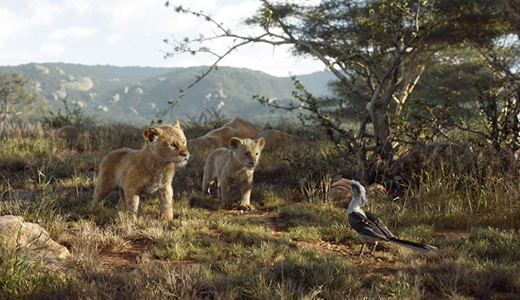The original Lion King, released in 1994, was a cartoon of the highest order—perhaps traditional Disney 2D animation at its peak. Hand-drawn manes flowed in the animated breeze, and a generation of families flocked to theaters to watch young Simba reclaim his birthright. The film made nearly $1 billion worldwide, which makes it—even 25 years after its release—the sixth highest-grossing animated film in the Disney catalog, and the most lucrative hand-drawn animated movie in history.
But as beautiful and intense and sad as it was, even young viewers knew that it was a story—cartoon characters playing make-believe in a cartoon world.
The new Lion King (which, as mentioned yesterday, made a boatload of money in its own right last weekend) follows a string of live-action remakes of Disney’s animated classics. And unlike its beloved predecessor, this one looks oh-so real. It blurs the line between “live action” and “cartoon” more than any other film ever made.
Is the new Lion King an animated movie? A live-action movie? That’s a surprisingly complicated question—even for its director, Jon Favreau. “It’s difficult because it’s neither, really,” he tells slashfilm.com.
While most blockbuster films today rely heavily on CGI, there’s usually still a recognizable human presence on screen. Iron Man is mostly digital when we see him fight on screen, but take off the CGI mask and we see the quite real Robert Downey Jr. Another Disney remake, 2016’s The Jungle Book, took us into an almost entirely digitized world, but a human Mowgli (played by Neel Sethi) still sat at its center—necessitating real sets and plenty of green screens and, at least, one cinematic foot in the real world.
But in the new Lion King, nothing on screen is, technically, alive—nor has it ever been. Not one animal, bird or blade of grass. Every element, as photo-realistic as it might be, is digitized. Strictly speaking, they all exist in a computerized netherworld. As director Jon Favreau told Entertainment Weekly:
By removing the one physical element of Mowgli, we were no longer tethered to the fact that we had to have blue screen or an actual set or real cameras, so everything became virtual at that point. Once that gave us the freedom to operate without actually having to move through physical photography, it allowed us to open ourselves up to a whole new approach, and that’s why it feels different than Jungle Book. We’ve basically built a multiplayer VR filmmaking game just for the purposes of making this movie.
But because that digital world was so richly rendered, the “filming” (if you can call it that) feels surprisingly like a live-action production. Favreau and his team could actually “scout locations together in real time in virtual reality,” according to EW. They’d set camera positions. They’d record multiple takes from multiple angles. Writes EW’s Marc Snetiker, “Save for the fact that everyone happens to be floating in the middle of the African sky, you’d swear this whole endeavor was just one craft-services table away from an actual movie set.”
The results are visually breathtaking and, many say, a little creepy. But perhaps the movie’s successes or failures aren’t as important as what this exercise in what’s being called “virtual production” presages for the future of filmmaking.
In Avengers: Endgame, another Disney film, several live-action characters were digitally youthified—again blurring the line between live-action and animation. In 2016’s Rogue One: A Star Wars Story, Grand Moff Tarkin—played in 1977 by a now very dead Peter Cushing—was resurrected via CGI. While that latter effort wasn’t particularly convincing, The Lion King shows how far technology has come in just three years. Could we reach a point where we no longer need real actors? Could our great-grandchildren watch an Iron Man reboot starring a digitized Robert Downey Jr.? (One would imagine that a CGI Downey would be significantly less expensive than the real one, too.)
Slate’s Sam Adams takes the question a step further.
How long will it be before the technology that allowed The Lion King’s cast and crew to virtually enter its world becomes available in Disney’s parks, or even at home, allowing us to go on an African safari without ever leaving the couch? The prospect of virtual tourism only becomes more attractive as the real world becomes less hospitable, as temperatures rise and class inequities grow. The Lion King isn’t just teaching us how to inhabit that world; it’s teaching us to prefer it. The Lion King’s virtual world has all the beauty of nature but none of the risks, none of the fragility—and none of the people. We can be alone, unencumbered, without worrying about the carbon footprint of our plane ticket or the systemic inequities of the local economy. It’s not just a world you can control. It’s a world you can own.
This technology has profound implications for families, too—especially moms and dads who are trying to teach their kids how to navigate the world around them.
Entertainment has long blurred the line between what’s real and what’s not, of course. (For weeks as a kid, thanks to some creative commercials, I was sure that biting into a bit of branded bubblegum would flood our house.) But now, in this age of easily manipulated photos and accusations of “fake news,” reality can be harder than ever to discern. Today’s parents must take children by the hand and help guide them through this bewildering time when what’s real and what’s not—an increasingly daunting task—and remind them that the difference between the two is just as important as it ever was.






Recent Comments